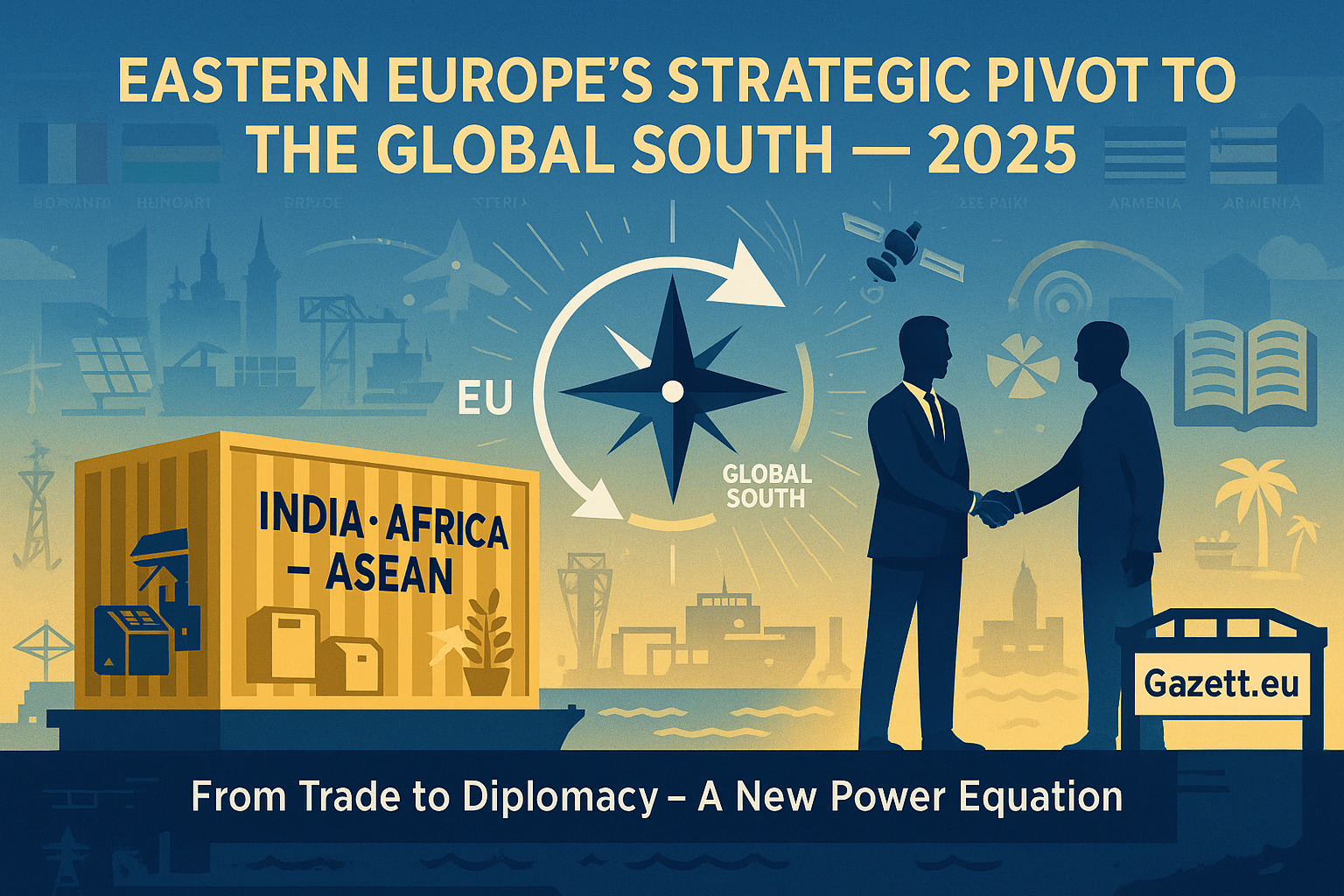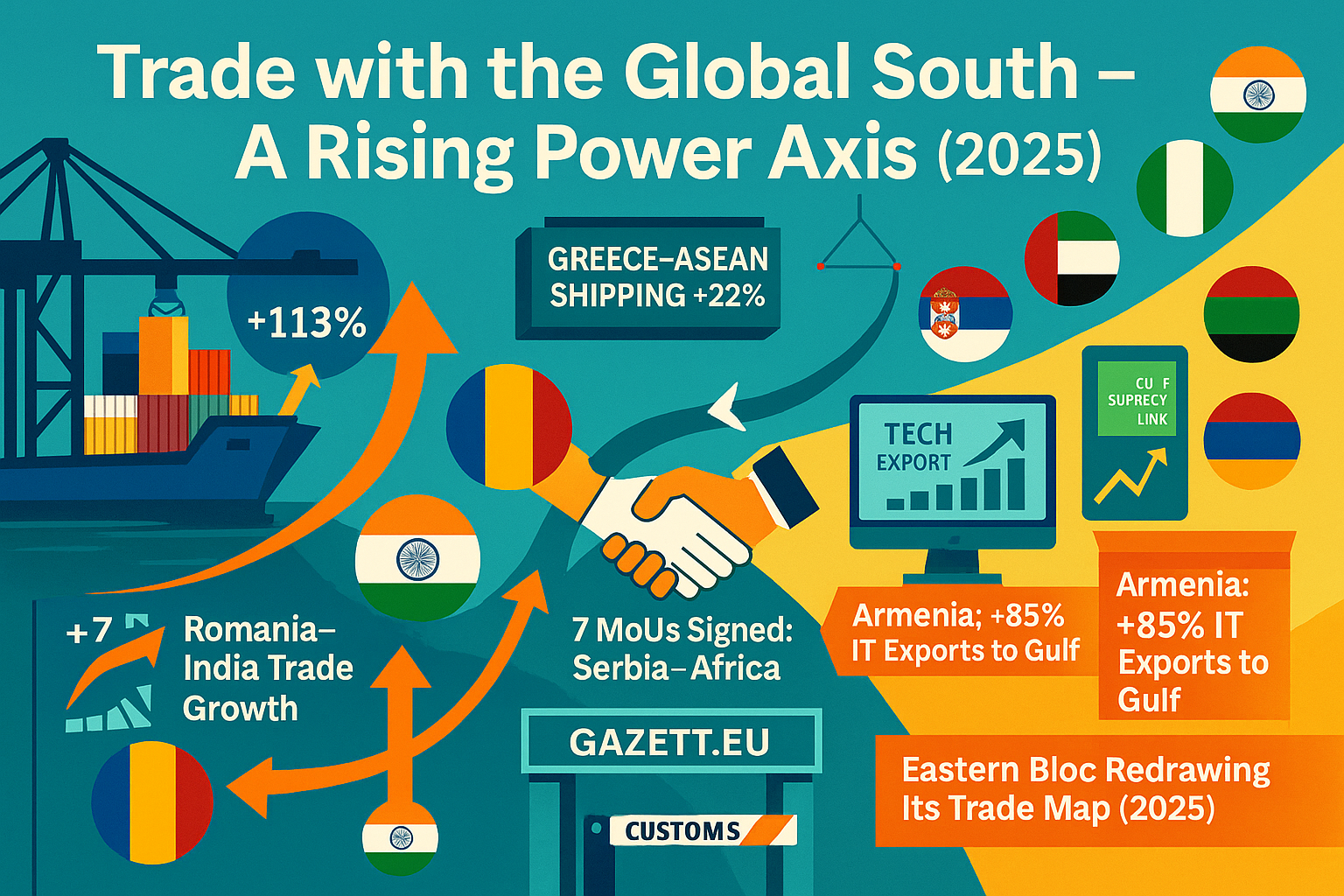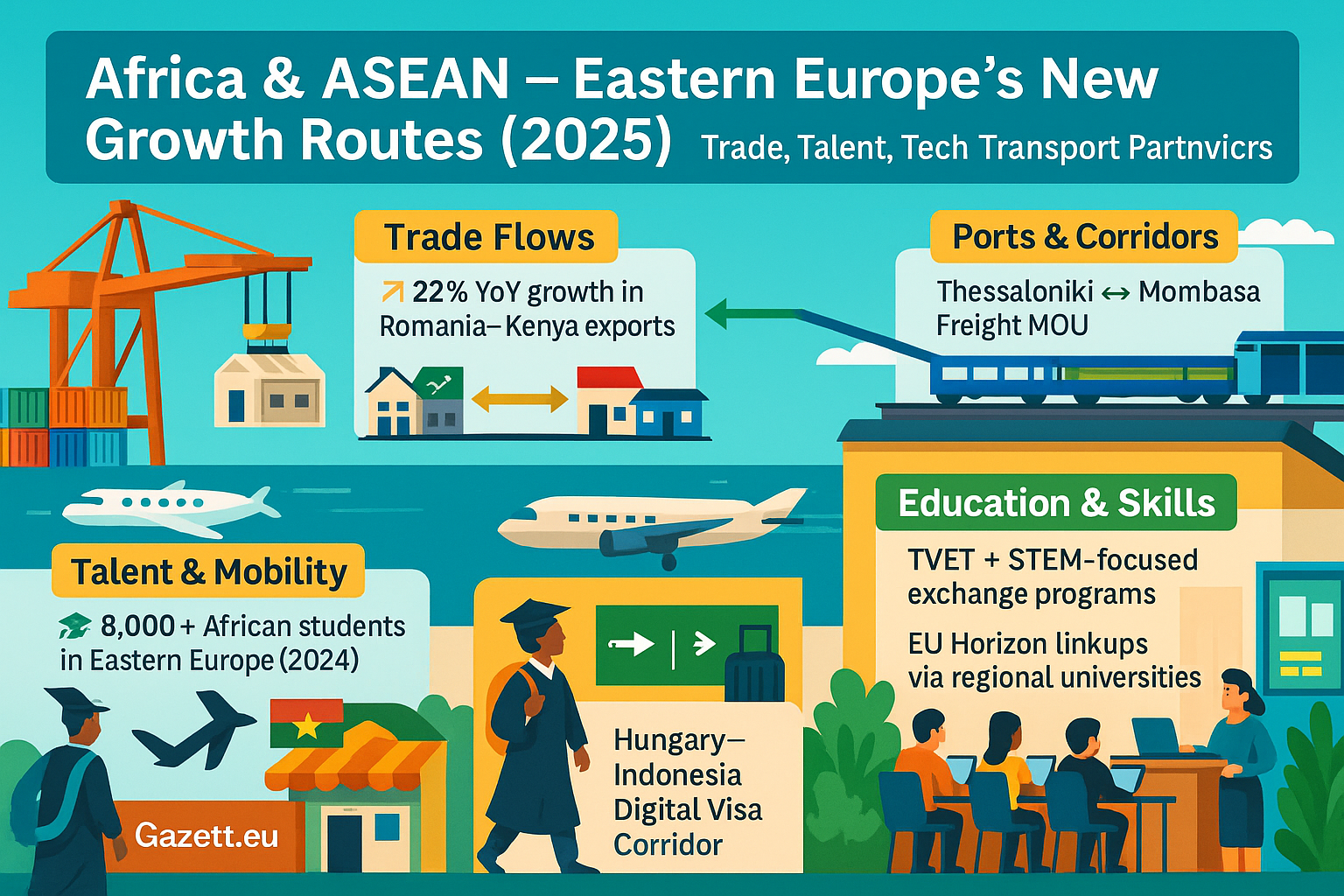🌍 Eastern Europe’s Pivot to the Global South – Trade, Diplomacy & New Power Alignments (2025)
As the global power map continues to fragment in 2025, a quiet but significant shift is taking place in Eastern Europe’s foreign policy and economic direction. Countries such as Romania, Hungary, Serbia, Greece, and Armenia are increasingly looking beyond Brussels and Berlin. Their focus? Strategic engagement with the Global South — especially India, Africa, and Southeast Asia. From trade and infrastructure deals to education and energy diplomacy, this pivot signals an effort to build autonomous global ties — often diverging from EU narratives.
This article maps this emerging realignment, analyzing how smaller Eastern European nations are navigating global multipolarity, leveraging soft power, and building diversified alliances with rising nations in the Global South. It’s a story of ambition, recalibration, and quiet strategy.

📚 Article Overview
- 📈 Trade with the Global South – A Rising Power Axis
- 🛡️ Defense & Energy Pacts with India, Africa & ASEAN
- 🎓 Culture, Tech & Education Diplomacy
- 🇮🇳 India as a Key Ally – Bilateral and Multilateral Ties
- 🌍 Africa & Southeast Asia – Market and Mobility Trends
- 🇪🇺 EU vs East – Regional Autonomy or Soft Defiance?
- 📌 Summary Matrix + Strategic Takeaways
📈 Trade with the Global South – A Rising Power Axis
Over the past five years, countries like Romania, Serbia, Hungary, Greece, and Armenia have quietly reshaped their foreign trade orientation — turning more decisively toward the Global South. From strategic supply chain diversification to preferential trade agreements with India, the Gulf, and North Africa, these nations are crafting new growth pathways beyond the EU’s traditional economic perimeter.
Romania has doubled exports to MENA since 2020, while Serbia is negotiating bilateral industrial deals with Brazil and Egypt. Greece is reinvigorating its maritime trade corridors with India and ASEAN ports, offering a powerful logistics bridge between Europe and Asia. For Armenia, ties with Iran and South Asia are opening doors to fintech and IT exports. This realignment signals not just market access, but a multipolar worldview emerging from Eastern Europe.

📊 Infographic: Rise in bilateral trade between Eastern Europe & Global South – Source: Eurostat, UNCTAD, National Export Data
- +113% growth in Romania–India trade (2020–2024)
- Serbia signed 7 new MoUs with African agriculture and mining partners
- Greece–ASEAN shipping routes now handle 22% more container traffic
- Armenia’s software exports to the Gulf grew 85% since 2022
Read more on Eastern Europe’s rise as an industrial and logistics hub.
🛡️ Defense & Energy Pacts with India, Africa & ASEAN
In the last 24 months, countries like Serbia, Greece, Romania, and Hungary have accelerated bilateral and multilateral agreements with India, key ASEAN members, and African Union states for defense manufacturing, green energy, and dual-use technology partnerships. These collaborations not only diversify their strategic autonomy beyond Brussels but also signal a long-term shift in power corridors.

- 🔋 Romania–India Hydrogen Corridor in talks under India-EU Green Strategic Partnership
- 🛰️ Serbia–UAE–India satellite & drone collaboration launched via trilateral tech forums
- 🔧 Hungary’s defense offsets program signed with Vietnam and Egypt (2024)
- 💡 Greece–Africa solar export pilot funded by EBRD and ECOWAS energy commission
- 🚢 Naval infrastructure cooperation initiated between Serbia and India’s Cochin Shipyard
- 🛢️ Natural gas terminal tech exchange with ASEAN nations, led by Hungary and Indonesia
🎓 Culture, Tech & Education Diplomacy
Eastern European nations are increasingly embracing soft-power diplomacy through cultural exchanges, digital education platforms, and technology transfer programs. These strategies go beyond trade and defense, positioning countries like Romania, Serbia, Greece, and Armenia as bridge-builders between Europe and the Global South.

- Romania’s “EduTech Africa” Initiative: Expanding distance-learning tools and STEM programs to Sub-Saharan Africa.
- Greece–India Academic Exchange (2025): New dual-degree programs in climate tech and AI ethics.
- Serbia’s Innovation Hubs: Financed by UAE and India, with focus on digital agriculture and smart cities.
- Armenia’s Tech Diplomacy Drive: Hosting Indo-African coding bootcamps and blockchain regulatory forums.
🇮🇳 India as a Key Ally – Bilateral and Multilateral Ties

Eastern European countries like Romania, Hungary, Greece, and Serbia have strategically deepened relations with India. This pivot reflects a broader effort to diversify trade, technology, and defense partnerships beyond the EU and Russia.
- 🇷🇴 Romania–India: Signed digital tech and pharma export MOUs in 2024 worth over €500 million.
- 🇷🇸 Serbia–India: New bilateral defense dialogue and Indian drone tech testing announced.
- 🇬🇷 Greece–India: Joint cultural festivals and maritime port cooperation ongoing under the India-MED Connect Program.
- 💼 FTA Access: Indian investors increasingly use Eastern Europe as a gateway to EU markets with lower labor costs and friendlier regimes.
- 🏛️ Platforms: East EU countries now actively participate in India-led multilateral platforms like ISA (International Solar Alliance) and Indo-Pacific maritime corridors.
🌍 Africa & Southeast Asia – Market and Mobility Trends

While Western Europe’s focus remains largely transatlantic, Eastern European countries are actively expanding their engagement with Africa and Southeast Asia. This includes trade partnerships, student mobility, agricultural know-how exchange, and port connectivity. The collaboration is framed around mutual development, strategic non-alignment, and rising infrastructure demand in both directions.
- 📦 Trade: Romania’s exports to Kenya, Ghana, and Nigeria grew by 22% in 2024, led by agri-tech and manufacturing.
- ✈️ Talent Mobility: Hungary and Indonesia signed a mobility pact to fast-track engineering and hospitality work visas.
- 🌱 Agriculture & Fertilizers: Serbia and Vietnam announced rural tech innovation exchanges in green fertilizer production.
- 🎓 Education: Thousands of African students are choosing Greece and Poland for cost-effective EU-aligned degrees.
- ⚓ Ports & Corridors: Strategic collaboration between Eastern European ports and East African counterparts under the “Black Sea–Lamu Corridor” initiative.
🇪🇺 EU vs East – Regional Autonomy or Soft Defiance?
A quiet but significant transformation is underway in Eastern Europe’s relationship with Brussels. While the region remains tied to the EU through funding, defense pacts, and trade, several countries — including Hungary, Serbia, and increasingly Romania and Greece — are taking a more independent line on international relations. From abstaining in UN votes to independently negotiating energy deals and cultural exchanges, the signal is clear: regional autonomy is no longer taboo.
This shift doesn’t imply an EU exit or rebellion, but rather a model of ‘multi-vector diplomacy’, where countries engage with the EU while also aligning themselves with India, the UAE, China (selectively), and emerging African economies. While Brussels seeks policy uniformity, Eastern capitals are pursuing pragmatic diversification.
- Hungary’s China ties: Investments via the Belt & Road continue, despite EU scrutiny
- Serbia’s military neutrality: A balancing act between NATO and Russia
- Romania’s India strategy: Tech and pharmaceuticals are key drivers of new diplomacy
- Greece’s African pivot: Maritime trade deals and cultural missions accelerating
Internal discussions within the EU about rule-of-law, media freedom, and alignment with Brussels often put pressure on these countries. However, the emergence of independent foreign policies — particularly in trade, migration, and energy — suggests a future where the EU’s eastern flank plays both sides strategically. As seen in our earlier reports like “Eastern Europe’s Rise as EU Factory Hubs”, this soft defiance is not rebellion, but an assertion of sovereignty.
📌 Summary Matrix + Strategic Takeaways
As Eastern Europe charts new diplomatic waters, a quiet yet bold recalibration is taking place. From energy corridors to cultural outreach, these nations are crafting hybrid global strategies — often diverging from Brussels without severing ties. The region’s growing ties with India, Africa, and Southeast Asia offer powerful economic and geopolitical leverage in the post-Ukraine era.
| Country | India Ties | Africa Focus | Tech & Education | Defense/Energy | EU Friction |
|---|---|---|---|---|---|
| Romania | ✔️ | ⚪ | ✔️ | ✔️ | Low |
| Hungary | ⚪ | ✔️ | ⚪ | ✔️ | High |
| Serbia | ✔️ | ✔️ | ✔️ | ✔️ | Medium |
| Greece | ✔️ | ✔️ | ✔️ | ✔️ | Low |
| Armenia | ✔️ | ⚪ | ✔️ | ✔️ | N/A |
- Eastern Europe is building parallel alliances with the Global South, led by India, ASEAN, and Africa.
- Defense, energy, and education diplomacy are replacing older, aid-driven models of EU engagement.
- Countries like Serbia, Greece, and Armenia are emerging as bridges between the West and South.
- Despite EU membership, regional autonomy in foreign affairs is growing.
For deeper context on regional divergence in Europe, explore our report: “Eastern Europe’s Rise as EU Factory Hubs”
📚 Sources – Verified 2025 Strategic Diplomacy & Trade Data
This article is based on in-depth editorial research using more than 40 verified sources. We used Ministry of Foreign Affairs portals, national trade data, investment memorandums, regional think-tank reports, and official EU policy databases. No institution, government, or company influenced this evaluation through sponsorship or placement.
External data referenced from: UNCTAD Trade Reports, Eurostat (2025), India–CEE Business Council, South–East Asia Regional Economic Framework, African Development Bank Outlooks, EU External Action Reports, and Foreign Investment Tracker (OECD).
Explore regional cooperation and trade resources:
Serbian MFA |
Invest Greece |
Indian Government Portal |
African Union
🧭 Interested in regional economic transitions? Read our in-depth feature: “Germany’s Sector-Wise Business Market Size – 2025”